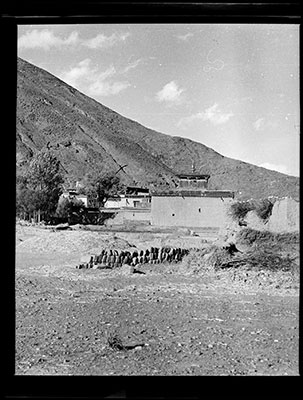
2001.59.2.54.1 (Film negative)


2001.59.2.54.1 (Film negative)

Hugh E. Richardson
Hugh Richardson
1948-50
Gyantse Region > Tsi Nesar
2001.59.2.54.1
43 X 54 mm
Negative film nitrate
Donated August 2001
The executors of the estate of Hugh E. Richardson
Hugh E. Richardson
Manual Catalogues - Notes on front of negative album in Richardson's hand in white: '2' 'Ramagang, 'Ushang, Tshurphu rgyal, Misc pillars'. On the reverse of negative album written in blue ink on white labels in Richardson's hand: 'Hu zhang, Pa blon chen, Pha bong ka, Nyenchen thang lho, Rva sgreng, Khro 'brug, etc. etc.' [KC 10/3/2006]
Manual Catalogues - Notes on negative index - Folio 54. 'Tsi Gnas gsar'.
Manual Catalogues - Richardson Hand List. 'Album No. 2 [nos.] 35-40. Three old temples attributed to 8th to 9th centuries at Gnas-gsar (Rtsis Gnas-gsar) between Gyantse and Shigatse.'
Other Information - Location: Richardson mentions this site in High Peaks, Pure Earth , London, Serindia Publications, 1998, pp. 326-7, " ... Rtsis Gnas-gsar (1950), a group of three early temples. The first, on the side of a hill, is the Ru-gnon temple, a small single-storeyed white building with a rgya-phibs covered in tiles of a Nepalese pattern. Inside is a fine Rnam-par snang-mdzad (Vairocana) holding a large round gold ornament. ... The temple is claimed to be one of Srong-brtsam sgam-po's foundations to dominate his frontiers.// Standing on level ground nearby is the largest temple, the Yum chen-mo. It is a square, wooden-framed building of two storeys with a small turret supported by a lantern frame and crowned by a slate rgya-phibs. ... The upper storey is supported by many-branched wooden pillars. ...// Opposite it is the temple of Rta-mgrin attributed to Ral-pa-can. ...// In the eleventh century monks of the later diffusion of the faith ( phyi-dar ) established themselves at Gnas-gsar, which later came under the control of Sa-skya; ..."
Other Information - The temples are attributed to King Songtsen Gampo and later expanded in the 8th Century by King Trisong Detsen to house an image of Prajnaparamita, which was consecrated by Padmasambhava. Richardson wrote in A Culture History of Tibet, " These (last) appear to be almost neglected and remains as examples of the very humble scale of some holy places built at that time." p. 89[TS 16/3/2005]
Other Information - Dates: The contact print of this image was developed with a related batch of negatives identifiable by the batch number '609', of which there are twently nine similarly marked 6x4.5 contact prints in the Richardson Collection in the Pitt Rivers Museum. Some of these prints have been dated by Richardson to October 1950, and others relate to places that he visited only in 1948-9 and it seems likely, therefore, that this image was taken within this period [MS 17/12/2005]
For Citation use:
The Tibet Album.
"The Yum Chenmo temple at Tsi Nesar"
05 Dec. 2006. The Pitt Rivers Museum.
<http://tibet.prm.ox.ac.uk/photo_2001.59.2.54.1.html>.
For more information about photographic usage or to order prints, please visit the The Pitt Rivers Museum.
© The Pitt Rivers Museum